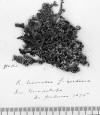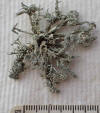|
Niebla isidiosa
is a fruticose lichen endemic to coastal areas of Baja California, on the
mainland near San San Quintín and on Isla Guadalupe. The species is
characterized by a rigid thallus divided into broad sublinear branches with a
reticulately ridged cortex producing abundant isidia along the cortical ridges,
by the branches abruptly recurved near branch tips, and by containing
divaricatic acid. It
resembles N.
caespitosa, in contrast to another divaricatic acid isidiate species, N. isidiaescens,
that resembles
N.
flagelliforma by the terminal branches recurved near to apex as seen in
the type and other specimens collected on the Vizcaíno Peninsula. They
differ from N. isidiosa in their more cylindrical shape with closely
reticulate ridges on terminal branches. However, other specimens of N.
isidiaescens collected on Mesa Camacho in the Northern Vizcaíno Desert
differ in having longer flexuous coiled branches; they probably belong to
another isidiate species with divaricatic acid.
Niebla isidiosa
was discovered on Isla Guadalupe by Palmer in 1875. Elix and McCarthy
later reported they found it on the island
(website, March 2005, with
reference to J. A. Elix. & P. M. McCarthy, 1998:
Catalogue of the lichens of the smaller Pacific Islands, Bibliotheca Lichenologica
70, 1 - 361). A more recent collection by Leavitt et al., 16-953, is from the
Baja California peninsula near San Quintín.
Another specimen collected by Leavitt et al.,16-775, identified Niebla
sp., shown above, was collected on the west slope of a volcano (Monte Ceniza). It differs from N. isidiosa by the more fragile thallus branches
appearing to disarticulate at various intervals, by the cylindrical branch shape, recessed
areoles between cortical ridges, branches tapering to a pointed apex, and
producing coralloid isidia.
Uniting the specimens under N. isidiosa is supported by DNA in Jorna
et al. (2021, Fig. 5);
however, there are many other examples where thalli appear similar but not
supported by DNA. In a limited selection of 40 specimens for evaluating
species delimitation in the genus Niebla (Jorna et al. 2021), N.
isidiosa was shown sister to N. flagelliforma, both in clade
sister to a sekikaic acid clade of N. cornea represented by four
specimens, two from the Channel Islands, the other two from the Punta Mazo
Reserve near San Quintín.
Additional References: See
Niebla.
|




